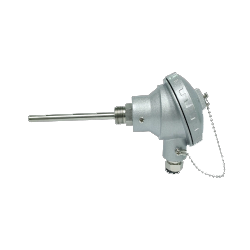RTD Sensors

Most resistance temperature detectors (RTDs) consist of a fine wire (typically platinum) wrapped around a ceramic core, exhibiting a linear increase in resistance as temperature rises. With a measuring range of -200 to 300 degrees C , RTDs generally have higher accuracy and repeatability than thermocouples, but their response times are slower.
-

Probes (with Connection Head) (7)
Most resistance temperature detectors (RTDs) consist of a fine wire (typically platinum) wrapped around a ceramic core, exhibiting a linear increase in resistance as temperature rises A1 Pt100 type RTD probes with IP67 connection heads offer a measuring range of -200 to 300 degrees C. -

Probes (Spring-loaded with Connection Head) (3)
Most resistance temperature detectors (RTDs) consist of a fine wire (typically platinum) wrapped around a ceramic core, exhibiting a linear increase in resistance as temperature rises. A1 Pt100 type RTD probes with IP67 connection heads and spring-loaded probes are used to assure target contact. Measuring range is -200 to 300 degrees C. -

Probes (with Hex Nipple) (3)
Most resistance temperature detectors (RTDs) consist of a fine wire (typically platinum) wrapped around a ceramic core, exhibiting a linear increase in resistance as temperature rises. A1 Pt100 type RTD probes with hex nipples allow easy probe replacement and connection to a junction box. Measuring range is -200 to 300 degrees C. -

Probes (with Attached Plug) (3)
Most resistance temperature detectors (RTDs) consist of a fine wire (typically platinum) wrapped around a ceramic core, exhibiting a linear increase in resistance as temperature rises. A1 Pt100 type RTD probes with an attached plug allow for quick and easy plug-in connections (mating connectors sold separately). Measuring rang is -200 to 300 degrees C. -

Probes (with Lead Wire Transition) (3)
Most resistance temperature detectors (RTDs) consist of a fine wire (typically platinum) wrapped around a ceramic core, exhibiting a linear increase in resistance as temperature rises. A1 Pt100 type RTD probes with heavy-duty 2 meters lead wire transitions allow easy connection to thermocouple extension wire. Measuring range is -200 to 300 C. -

Sensors (Adjustable Immersion) (1)
Most resistance temperature detectors (RTDs) consist of a fine wire (typically platinum) wrapped around a ceramic core, exhibiting a linear increase in resistance as temperature rises. These Pt100 type adjustable-depth immersion sensors have integral bayonet caps for easy installation (use with bayonet or pipe adapters). Measuring range is -200 to 300 degrees C. -

Sensors (Sus Lug Ring) (2)
Most resistance temperature detectors (RTDs) consist of a fine wire (typically platinum) wrapped around a ceramic core, exhibiting a linear increase in resistance as temperature rises. A1 Pt100 type lug ring sensors are ideal for nozzles, extruder barrels, die heads, molds and other surface sensing applications. Measuring range is -200 to 300 degrees C.


